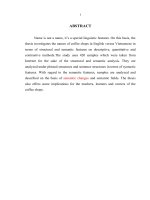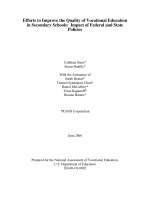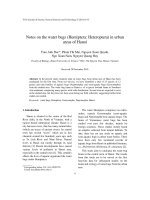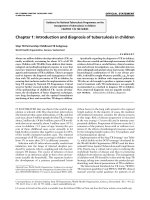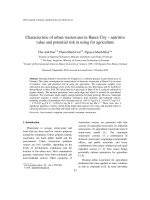level of autonomy on the management of vocational schools in hanoi city, vietnam
Bạn đang xem bản rút gọn của tài liệu. Xem và tải ngay bản đầy đủ của tài liệu tại đây (1.48 MB, 179 trang )
i
THAI NGUYEN UNIVERSITY
Socialist Republic of Vietnam
SOUTHERN LUZON STATE
UNIVERSITY
Republic of the Philippines
LEVEL OF AUTONOMY ON THE MANAGEMENT OF
VOCATIONAL SCHOOLS IN HANOI CITY, VIETNAM
A RESEARCH PRESENTED TO THE FACULTY OF GRADUATE SCHOOL
SOUTHERN LUZON STATE UNIVERSITY LUCBAN, QUEZON, PHILIPPINES
THAI NGUYEN UNIVERSITY S.R. VIETNAM
IN PARTIAL FULFILLMENT OF THE REQUIREMENTS FOR THE DEGREE
DOCTORS IN BUSINESS ADMINISTRATION
Phạm Quang Vinh (Stone)
Thai Nguyen, 2013
ii
APPROVAL SHEET
In partial fulfillment of the requirements for the degree Doctor in Business Administration,
this research study entitled LEVEL OF AUTONOMY ON THE MANAGEMENT OF
VOCATIONAL SCHOOLS IN HANOI CITY, VIETNAM has been submitted by Phạm
Quang Vinh (Stone) and is hereby recommended for oral examination.
Prof Dr. Do Anh Tai
Adviser
Approved by the Oral Examination Committee, in partial fulfillment of the
requirements for the degree Doctor in Business Administration offered by Southern Luzon
State University, Republic of the Philippines in collaboration with Thai Nguyen University,
Socialist Republic of Vietnam.
………………………………………. ……………………………………….
Member Member
……………………………………….
Chairman
Accepted in partial fulfillment of the requirements for the degree Doctor in Business
Administration offered by Southern Luzon State University, Republic of the Philippines in
collaboration with Thai Nguyen University, Socialist Republic of Vietnam.
____________ TERESITA V. DE LA CRUZ, Ed. D
Date Dean, Graduate School
iii
ACKNOWLEDGMENT
In grateful recognition and sincerest thanks for the encouragement, guidance and
unselfish sharing of their knowledge, time, effort and skills, and for the untiring motivation
that leads to the completion of this study, the researcher acknowledges the following:
DR. CECILIA N. GASCON, Ph.D., President of the Southern Luzon State University
in the Republic of the Philippines, for her untiring effort and belief that this collaboration is
possible thus enabling us to pursue the DBA degree;
DR. DANG XUAN BINH, Ph.D., Director of the International Training Center, Thai
Nguyen University of the Socialist Republic of Vietnam, for his enormous pursuit to provide
the Vietnamese people an opportunity to grow through education;
DR. DO ANH TAI , Ph.D., his adviser, for guidance and endless support for the
improvement of this study.
ITC STAFF, for providing the necessary research materials;
MANAGERS and STAFF of Vocational Schools in Hanoi city, my Respondents, for
their patience and cooperation in answering the questionnaire and for other data given;
MY FAMILY and FRIENDS, for the love and support in one-way or the other; and
TO ALL who have contributed to make this study a success.
Phạm Quang Vinh (Stone)
iv
DEDICATION
This research is healthfully dedicated
To my family and to all my relatives, my colleagues,
friends, classmates, administrators, staffs and employees
for Vocational Schools In Hanoi city.
Phạm Quang Vinh (Stone)
v
Table of Contents
Title Page Page
Approval Sheet ii
Acknowledgment iii
Dedication iv
Table of Contents v
List of Figures x
List of Table xi
Abstracts xv
Abbreviations xvi
Chapter I. Problem and Its Setting
1
1.1. Introduction 1
1.2. Background of the study 2
1.3. Objective of study 4
1.4. Statement of the Problem 5
1.5. Hypotheses 5
1.6. Significance of the study 5
1.7. Scope and Limitations 6
1.8. Definition of terms 6
Chapter II. Review of Related Literatures and Studies
8
2.1. Related Concepts and Review of School Autonomy 8
2.1.1. Concept on Education and Vocational school 8
2.1.1.1. Education 8
2.1.1.2. Education as National and as Social 8
2.1.1.3. Vocational education 13
vi
Title Page Page
2.1.2. The problems of autonomy and autonomy schools 19
2.1.2.1. Autonomy 19
2.1.2.2. Effective autonomy 20
2.1.2.3. School autonomy 21
2.1.3. Overview on status of education system and school autonomy in
Vietnam
34
2.1.3.1. Structure of Vietnam education system and its actives 34
2.1.3.2. Occupational Education Institutions 37
2.1.3.3. School Autonomy in Vietnam 38
2.1.4. The Factors related to school autonomy 40
2.2. Related Literatures and Studies 42
2.3. Conceptual Framework 45
Chapter III. Methodology
46
3.1. Research design 46
3.2. Determination of sample size 46
3.3. Sampling design and techniques 47
3.4. Subject of the study 47
3.5. Research instrument 47
3.6. Validation of the instrument 48
3.7. Data gathering procedure 48
3.8. Data processing method 49
3.9. Statistical treatment 49
Chapter IV. Presentation, Analysis and Interpretation of Data
50
4.1. Profile of respondents 50
vii
Title Page Page
4.2. Assessment of the respondents on the existing level of autonomy on
management of Vocational schools in Hanoi city, Vietnam with regard to
Identifying of Organizational autonomy, financial autonomy, Staffing
autonomy, and Academic autonomy
52
4.2.1. Organizational autonomy in public and private vocational schools in
Hanoi city
53
4.2.1.1. Organizational autonomy in public vocational schools 53
4.2.1.2. Organizational autonomy in private vocational schools 57
4.2.1.3. Comparing of Organizational autonomy in public and private
vocational schools in Hanoi city
61
4.2.2. Finacial autonomy in public and private vocational schools in Hanoi 66
4.2.2.1. Finacial autonomy in public vocational schools 66
4.2.2.2. Finacial autonomy in private vocational schools 69
4.2.2.3. Compare Finacial autonomy in public and private vocational
schools in Hanoi
72
4.2.3. Staffing autonomy in public and private vocational schools in Hanoi 76
4.2.3.1. Staffing autonomy in public vocational schools 76
4.2.3.2. Staffing autonomy in private vocational schools 79
4.2.3.3. Compare Staffing autonomy in public and private vocational
schools in Hanoi
82
4.2.4. Academy autonomy in public and private vocational schools in Hanoi 86
4.2.4.1. Academy autonomy in public vocational schools 86
4.2.4.2. Academy autonomy in private vocational schools 89
4.2.4.3. Compare Academy autonomy in public and private vocational
schools in Hanoi
92
4.3. The autonomy factors were enjoined much or least of the vocational 96
viii
Title Page Page
schools as perceived by respondents
4.3.1. Determining importance of Organization autonomy in vocational
schools
96
4.3.2. Determining importance of Financial autonomy in vocational schools 98
4.3.3. Determining importance of Staffing autonomy in vocational schools 100
4.3.4. Determining importance of Academy autonomy in vocational schools 102
4.3.5. Sum up of importance of autonomy factors in vocational schools 104
4.4. Factors should be the extent of autonomy on the given indicators that
may be spelled out by Private and Public vocational schools.
106
4.5. Testing a significant differences between profile of respondents and their
perception on the level of autonomy on management of Vocational schools in
Hanoi city, Vietnam
108
Chapter 5. Findings, Conclusions and Recommendations
121
5.1. Summary 121
5.2. Findings 121
5.2.1. Demography 121
5.2.2. The existing level of autonomy on management of vocational schools
in Hanoi city
122
5.2.3. The autonomy factors were enjoined much or least of the vocational
schools as perceived by respondents
123
5.2.4. Items should be extent of autonomy on the given indicators that may
be spelled out by Private and Public vocational schools
124
5.2.5. Testing null hypothesis 124
5.3. Conclusions 125
5.4. Recommendations 126
5.4.1. Solutions to improve the management autonomy in vocational schools 126
ix
Title Page Page
in Hanoi
5.4.2. Other solutions 128
5.2.3. Planning to support the autonomy to develop the vocational schools 128
Bibliography
130
Appendix A: Questionaire Checklist
136
Appendix B: Raw Data
150
Appendix C: ANOVA Tables
151
Curriculum Vitae
161
x
List of Figures
Figures Title Page
2.1
Ability to keep a surplus
26
2.2
Ability to sell school-owned real Estate
27
2.3
Overall student numbers
32
2.4
The education system in Vietnam
35
2.5
Research model for assessment of level of autonomy on the
management of vocational schools in Hanoi, Vietnam
45
xi
List of Table
Table Title Page
2.1
Requirements for implementing autonomy, assessment and
accountability
20
2.2 Dimension of School autonomy 22
2.3
Qualifications of the executive head
23
2.4
Restrictions on senior academic staff recruiment
29
3.1 Description of Respondents 47
3.2
Ratting scale for respondent’s perception on contents in autonomy
actives at vocational schools in Hanoi city
48
3.3
Type of data and methods of gatherning and processing
49
4.1.1
Frequency Distribution of Respondent’s Profile as Indicated by Age,
Gender, and Education
50
4.1.2
Frequency Distribution of Respondent’s Profile as Indicated by Length of
Services in the department, and working division
51
4.2.1
Mean Distribution of Responses on the existing level of autonomy on
management of Public Vocational schools in Hanoi city in terms of to
Identifying of Organizational autonomy
53
4.2.2
Mean Distribution of Responses on the existing level of autonomy on
management of Private Vocational schools in Hanoi city in terms of to
Identifying of Organizational autonomy
57
4.2.3
Composite of Mean Distribution of Responses on the existing level of
autonomy on management of Vocational schools in Hanoi city in terms
of to Identifying of Organizational autonomy
61
4.2.4
Mean Distribution of Responses on the existing level of autonomy on
management of Public Vocational schools in Hanoi city in terms of to
Identifying of Financial autonomy
66
xii
Table Title Page
4.2.5
Mean Distribution of Responses on the existing level of autonomy on
management of Private Vocational schools in Hanoi city in terms of to
Identifying of Financial autonomy
69
4.2.6
Composite of Mean Distribution of Responses on the existing level of
autonomy on management of Vocational schools in Hanoi city in terms
of to Identifying of Financial autonomy
73
4.2.7
Mean Distribution of Responses on the existing level of autonomy on
management of Public Vocational schools in Hanoi city in terms of to
Identifying of Staffing autonomy
76
4.2.8
Mean Distribution of Responses on the existing level of autonomy on
management of Private Vocational schools in Hanoi city in terms of to
Identifying of Staffing autonomy
79
4.2.9
Composite of Mean Distribution of Responses on the existing level of
autonomy on management of Vocational schools in Hanoi city in terms
of to Identifying of Staffing autonomy
82
4.2.10
Mean Distribution of Responses on the existing level of autonomy on
management of Public Vocational schools in Hanoi city in terms of to
Identifying of Academic
86
4.2.11
Mean Distribution of Responses on the existing level of autonomy on
management of Private Vocational schools in Hanoi city in terms of to
Identifying of Academic
89
4.2.12
Composite of Mean Distribution of Responses on the existing level of
autonomy on management of Vocational schools in Hanoi city in terms
of to Identifying of Academic
92
4.3.1
Mean Distribution of Responses on the importance of Organization
autonomy in public vocational schools in Public Vocational schools in
Hanoi city
97
4.3.2
Mean Distribution of Responses on the importance of financial
autonomy in public vocational schools in Public Vocational schools in
99
xiii
Table Title Page
there is significant in relation between respondent’s working
division and their perception on school autonomy in item of
Hanoi city
4.3.3
Mean Distribution of Responses on the importance of Staffing
autonomy in public vocational schools in Public Vocational schools in
Hanoi city
101
4.3.4
Mean Distribution of Responses on the importance of Academic
autonomy in public vocational schools in Public Vocational schools in
Hanoi city
103
4.3.5
Composite off Mean Distribution of Responses on the importance of
autonomy factors in vocational schools in Hanoi city
105
4.4.1
Mean Distribution of Responses on the Factors should be the extent of
autonomy on the given indicators that may be spelled out by Private and
Public vocational schools in Hanoi city
107
4.5.1a
Significant Difference between the Respondent’s position and their Perception
on the level of autonomy on management of Public vocational schools in
Hanoi city, Vietnam
108
4.5.1b
Significant Difference between the Respondent’s position and their Perception
on the level of autonomy on management of Private vocational schools in
Hanoi city, Vietnam
109
4.5.2a
Significant Difference between the Respondent’s age bracket and their
Perception on the level of autonomy on management of Public Vocational
schools in Hanoi city, Vietnam
110
4.5.2b
Significant Difference between the Respondent’s age bracket and their
Perception on the level of autonomy on management of Private Vocational
schools in Hanoi city, Vietnam
111
4.5.3a
Significant Difference between the Respondent’s Education and their
Perception on the level of autonomy on management of Public Vocational
schools in Hanoi city, Vietnam
112
xiv
Table Title Page
4.5.3b
Significant Difference between the Respondent’s Education and their
Perception on the level of autonomy on management of Private Vocational
schools in Hanoi city, Vietnam
113
4.5.4a
Significant Difference between the Respondent’s Gender and their Perception
on the level of autonomy on management of Public Vocational schools in
Hanoi city, Vietnam
114
4.5.4b
Significant Difference between the Respondent’s Gender and their Perception
on the level of autonomy on management of Private Vocational schools in
Hanoi city, Vietnam
115
4.5.5a
Significant Difference between the Respondent’s Experience and their
Perception on the level of autonomy on management of Public Vocational
schools in Hanoi city, Vietnam
116
4.5.5b
Significant Difference between the Respondent’s Experience and their
Perception on the level of autonomy on management of Private Vocational
schools in Hanoi city, Vietnam
117
4.5.6a
Significant Difference between the Respondent’s working division and their
Perception on the level of autonomy on management of Public Vocational
schools in Hanoi city, Vietnam
118
4.5.6b
Significant Difference between the Respondent’s working division and their
Perception on the level of autonomy on management of Private Vocational
schools in Hanoi city, Vietnam
119
4.5.7
Significant Difference between Public and Private School’s Evaluation on the
level of autonomy on management of Vocational schools in Hanoi city,
Vietnam
120
xv
Abstract
This dissertation with the title "LEVEL OF AUTONOMY ON THE MANAGEMENT
OF VOCATIONAL SCHOOLS IN HANOI CITY, VIETNAM ", the objective of this study is
to evaluate the reality autonomy of schools in vocational schools in Hanoi, review of
literatures about the autonomy of schools in general and in vocational schools in particular.
This study reviews operational status of autonomy in vocational schools in Hanoi through
groups such as the basic criterion to determine the real situation and the key element for
autonomy in vocational school in Hanoi. This study used methods of descriptive statistics, the
method of comparison statistics and analysis of variance through the selection of two types of
vocational school in Hanoi. It's public and private vocational schools. There are two groups of
respondent in each type of school have been chosen to measure their perceptions about
managing the operation autonomy in schools. Research has shown that the operating
autonomy of the vocational school in Hanoi in the first phase of the cultural autonomy of
schools. The concept, content and the policy on school autonomy has not been publicized.
Hypothesis test results also show that there is not much difference in the perception of the
respondent group about the status of content management autonomy in vocational schools in
Hanoi.
xvi
ABBREVIATIONS
AT Austria
BE fr Belgium/French Community
BE nl Belgium/Flemish Community
BG Bulgaria
BPNT Basic Psychological Needs Theory
CET Cognitive Evaluation Theory
CH Switzerland
COT Causality Orientations Theory
CY Cyprus
CZ Czech Republic
DE Germany
DK Denmark
EE Estonia
ES Spain
FI Finland
FR France
GCT Goal Contents Theory
GDV General Department of Vocational
GR Greece
HNETO Hanoi Education and Training Office
HR Croatia
HRM Human Recourse Management
HU Hungary
IS Iceland
IT Italy
LT Lithuania
LU Luxembourg
LV Latvia
MOET Ministry of Education and Training
MOLISA Ministry of Labour - Invalids - Social Affairs
MT Malta
NL Netherlands
xvii
NO Norway
OEI Occupational Education Institution
OIT Organism Integration Theory
PIED Professional Intermediate Education Department
PIS Professional Intermediate School
PL Poland
PT Portugal
RO Romania
RS Serbia
SDT Self-Determination Theory
SE Sweden
SI Slovenia
SK Slovak Republic
TR Turkey
UK United Kingdom
VC Vocational College
VS Vocational School
1
CHAPTER I
THE PROBLEM AND ITS SETTING
1.1. Introduction
Autonomy is a topic of great interest, which is often mentioned in the forums of
education - training in Vietnam. It is most concerned by the schools as well as the state
management agencies with many opinions and conflicting viewpoints. Although the general
direction is bold autonomy and self-responsibility of the schools to increase their flexibility,
many specific issues that are given out to discuss such as: Licensing and how to license; How
is the mechanism of state control to let off without relinquishing management while
enhancing the effective operation of the school, etc.
Autonomy of institutions in the field of education is understood as self-determination
and self-responsibility under the laws and the requirements of society for all its activities such
as finance, personnel and organizational structure, training programs, strategic planning, etc.
Under the provisions of Vietnam laws, the level of autonomy of the education and
training institutions (collectively, the schools) depends on the type of school. Currently in
Vietnam, the system of Occupational Education includes the Professional Intermediate
Schools, Vocational Schools, Vocational Colleges, and some Colleges and Universities,
which has Vocational Education models (after here, referred to as Vocational School) under
two different types (Nguyen Duc Toan, 2010):
- Private Schools: all of them are full autonomy.
- Public Schools: three kinds that are none autonomy, partial autonomy, and full
autonomy.
Each type of school is influenced by the different legal documents and regulations on
its autonomy.
Autonomy does not mean relinquishing management from the state. In contrast,
autonomy given to schools is considered as one of the most important solutions to bring
motivations, new life for training institutions to improve the efficiency, educational quality
and social responsibility of the schools.
Vietnam is in the process of institutional transformation from the planning -
bureaucracy - subsidy economy to the market economy completely. Accordingly, education
2
and training is not only seen as a public utility sector, but also considered an important
service sector that has been contributing significantly to the sustainable development of
market economy. Ensuring autonomy for training institutions is a prerequisite for these
institutions to adjust their activities in accordance with market mechanism, which requires the
dynamic, creation, activeness and accepts the changes frequently.
The scope of this study will try to approach a relative full - autonomy of the
occupational education institutions and its impacts on the activities of these schools; This
study also will try to compare the existing legal provisions issue with some experiences of
developed countries to put forward some recommendations to improve and enhance the
effectiveness of the policy framework for Occupational Education field as well as the
advancement of each school.
1.2. Background of the study
The developments towards a different model of governance in many advanced
societies have been characterized with the phrase “regulatory state” (Moran 2002), i.e. a state
where direct public ownerships is replaced by regulating more autonomous units. Higher
education is subject to similar changes and is waiting for a systematic analysis from a
regulatory approach (King 2007). As a general rule, vocational schools have become more
autonomous – free from line-itemized budgets, input control, and detailed prescriptions on
curricula (Santiago et al. 2008). The greater autonomy is at the same time balanced by new
accountability mechanisms (Santiago et al. 2008). Therefore, the autonomy of the schools is
limited to make the selection of the training majors as well as to determine the suitable
training model upon requests of the labour markets and training capacities of schools actively.
With the Circular No115/2010/ND-CP dated 24/12/2010 of the Government, this
responsibility has been transferred to the local Education & Training departments. However,
these departments are also getting many embarrassments and difficulties in dealing with this
new task which leads to the delays, lack of the uniformity on the steps of approving the
procedures to open new majors and giving the annual recruitment quantity, GOV (2010).
At present, Vietnam doesn’t have enough the particular laws to encourage the
enterprises and schools to cooperate closely so as to train students to meet the demands of the
labour market. Schools still train students with their own programs without being concerned
much about what the labour market requires. The stagnations, the inactiveness of the schools
3
are affected directly by the management methods, which are lack of the motivation and exist
the bureaucracies of the managers and leaders.
The Vietnam Educational Law still remains the classification of the state management
function in the area of occupational education for the MOET (manage the intermediate
professional schools) and MOLISA (manage the vocational schools, vocational colleges).
This separation has caused the inequality, dispersion and reduced effectiveness of the
resources invested in the occupational education area. Moreover, it also limits the autonomy
of the occupational education institutions to diversify the training programs, levels of training,
and the links among the training programs and levels of training. Beside, being lack of the
financial resources is one of the main reasons that cause the limitations of the autonomy of
the occupational education institutions, especially the autonomy and self - responsibilities for
the training quality.
In addition, the effectiveness of the financial investments for occupational education area
is not high, not focused, and hasn’t encouraged the schools to improve the quality. The private
occupational education institutions will encounter a lot of difficulties in dealing with the
procedures to ask for permission to open new school, being provided with lands to build
school, approving the training programs. They are not behaved as equally as the public
schools and it is difficult for them to approach supported policies for the development of
occupational education from the Government. Therefore, the autonomy of the private schools
in Vietnam is considered like the laxity and lack of support at some points. Some major
problems exist in occupational education policy in Vietnam at present: The classification and
allocation of the state management in the occupational education are inappropriate. There are
many different points between the MOET and MOLISA on development policy of the
occupational education system that hasn’t been solved properly (Nguyen Van Khoi , 2012).
The unbalanced allocation of investment projects to develop vocational capacity between
vocational schools and intermediate professional schools. The development of the intermediate
professional education system is not paid attention properly by MOET. It is lack of transparency
and consistency in decentralized management occupational education sector between the state
management agencies. These problems cause a lot of obstacles and embarrassing for the
occupational educational institutions in implementing their autonomy.
The coexistence of two systems of the state management in occupational education leads
to inconsistencies, inequalities among different models of schools.
4
It does not only creates the legal barriers related to the links among the levels of training
of the National Education System, but also limits the autonomy of the schools in building their
training programs that can meet the requirements of the labour market.
Beside the challenges and difficulties mentioned above, there are some basic advantages,
which are the Government's policies on enhancing the autonomy and self-responsibility of the
educational organizations, including occupational education establishments.
Currently, autonomy is inevitable trend of the policy orientation in the development of
education and occupational education sector in Vietnam. Autonomy can be considered as a key
tool to reform and revive the occupational education system in Vietnam.
This research will study on the current status of the autonomy of the occupational
educational institutions to point out the critical issues that are existing in the occupational
education system related to the autonomy of the schools in Hanoi city. It will also raise some
recommendations to improve the legal framework towards increasing autonomy and social
responsibility of the occupational educational institutions. Based on that, this study will give out
useful lessons to develop the policy framework of occupational education sector in Vietnam.
1.3. Objective of study
1.3.1. General objective of study
The goal of this study is focus on the evaluation of management status of the
autonomy of at the vocational schools in Hanoi city, Vietnam and then this study will to point
out the recommend and solution that have improved the problems and limited in managing
autonomy at the Vocational schools in Hanoi city.
1.3.2. General objective of study
Determine respondent’s perception on Autonomy in the operation of public and
private vocational schools in Hanoi city.
Determine and compare the level of autonomy between the public and private
vocational schools.
Determine which of the areas is perceived as the top priority for autonomy between
public and private vocational schools in Hanoi city.
5
1.4. Statement of the Problem
1.4.1. The basic information exploited from the interviewees under the angles of:
− Ages
− Qualifications
− Job positions
− Gender
− Working experiences in education & training field.
1.4.2. What is the existing level of autonomy on management of vocational schools in
Hanoi city, Vietnam in items of:
− Organisational autonomy
− Financial autonomy
− Staffing autonomy
− Academic autonomy
1.4.3. Which of the autonomy factors were enjoined much or least of the vocational
schools as perceived by respondents?
1.4.4. What should be the extent of autonomy on the given indicators that may be spelled
out by Private and Public vocational schools?
1.4.5. What plan program can be developed to support the autonomy to develop the
vocational schools?
1.5. Hypotheses
There is no significant different on perceived autonomy by group of respondent and their
profile.
1.6. Significance of the study
For the researched organization: Autonomy for Education and Training institutions
will be an opportunity to make their own orientation in accordance with the characteristics
and circumstances of each school.
For the managers: There are helpful hints in the uses of effective autonomy as a tool
to improve the quality of the schools and the effectiveness of the state management in the
occupational education system.
6
For the researcher: Apply obtained knowledge to do research and the researcher is
also the leader of a professional secondary school, therefore the school will also get the
benefits from the results of this study.
For the other researchers: Result report of this study is a useful reference for
the other researchers to study the similar problems in the future.
1.7. Scope and Limitations
This study is descriptive researches that will assess the status of school autonomy at
vocational school in Hanoi city through analyzing impact of factors that relevant to autonomy
actives in vocation public and private schools in Hanoi city of Vietnam. Autonomy actives in
vocational schools in Hanoi will be evaluated based on the following variables as Academic
autonomy, financial autonomy, Organizational autonomy, and Staffing autonomy.
The respondents will be multi sectors, the manager, teacher, and Lecturer who have
been working at vocational schools in Hanoi city and they will be subjected on the use of
questionnaire check list and Interview. Previous studied on autonomy in schools will also use
for check and balances purposes.
Due to limited time and other resources, the researcher just collected a total of 539
respondents from public and private vocational school in Hanoi city based on a formula for
calculating total sample.
A five-point scale was used to determine the perception of respondents on the existing
level of autonomy on management of vocational schools.
1.8. Definition of terms
Autonomy is as old as the tradition of higher education. Complete autonomy implies
that the higher education institutions concerned are self-governing communities with no
control from governments or other outside bodies on their internal activities.
Academic autonomy refers to a school’s ability to decide on various academic issues,
such as student admissions, academic content, quality assurance, the introduction of degree
programmers and the language of instruction.
7
Financial autonomy refers to a school’s ability to decide freely on its internal
financial affairs. The ability to manage its funds independently enables an institution to set
and realize its strategic aims.
Organizational autonomy is an art practice as a Not For Profit Organization, whose
projects are subject to the oversight of a Board of Directors. It is a device for fragmenting the
authoritarian vision of the artist through a collective process, and aligning with and redefining
what it means to work in the public interest.
Staffing autonomy refers to a school’s ability to decide freely on issues related to
human resources management, including recruitments, salaries, dismissals and promotions.
8
CHAPTER 2
REVIEW OF RELATED LITERATUES AND STUDIES
This chapter will present concepts and theories that have significant effects on the
conduct of the study. The review of related literatures and study would present what had been
written about the subject. Finally a Conceptual framework that will aid the conduct of this
research work will be established.
2.1. Related Concepts and Review of School Autonomy
2.1.1. Concept on Education and Vocational school
2.1.1.1. Education
According to Maarja Beerkens (2006), Education is the very nature of life to strive to
continue in being. Since this continuance can be secured only by constant renewals, life is a
self-renewing process. What nutrition and reproduction are to physiological life, education is
to social life? This education consists primarily in transmission through communication.
Communication is a process of sharing experience till it becomes a common possession. It
modifies the disposition of both the parties who partake in it. That the ulterior significance of
every mode of human association lies in the contribution, which it makes to the improvement
of the quality of experience is a fact most easily recognized in dealing with the immature.
That is to say, while every social arrangement is educative in effect, the educative effect first
becomes an important part of the purpose of the association in connection with the association
of the older with the younger. As societies become more complex in structure and resources,
the need of formal or intentional teaching and learning increases. As formal teaching and
training grow in extent, there is the danger of creating an undesirable split between the
experience gained in more direct associations and what is acquired in school. This danger was
never greater than at the present time, on account of the rapid growth in the last few centuries
of knowledge and technical modes of skill.
2.1.1.2. Education as National and as Social
As soon as the first enthusiasm for freedom waned, the weakness of the theory upon
the constructive side became obvious. Merely to leave everything to nature was, after all, but
to negate the very idea of education; it was to trust to the accidents of circumstance. Not only
was some method required but also some positive organ, some administrative agency for
carrying on the process of instruction. The "complete and harmonious development of all
powers," having as its social counterpart an enlightened and progressive humanity, required

